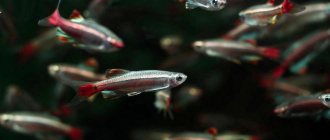Author: Andrey
October 23, 2015 11:53
Tags: giant fish from around the world
3820
11
A large fish is a source of pride for every fisherman. What can you say about a fish that is larger than a human being? This is the ultimate dream for every avid fisherman! Fans of freshwater fishing share photos of their trophies on social networks every day. Looking at such photographs, you never tire of being amazed at the diversity of our nature.
0
See all photos in the gallery
Fish-Napoleon
The fish are most often found among calcareous geological structures in the Red Sea, Pacific and Indian Oceans. Habitat depth: 1–100 meters.
This is the longest fish of the wrasse family. Adult specimens can reach a length of 230 cm. The average body length is 60 cm. Giants weigh over 190 kg.
The family got its name from its plump lips, thick forehead and clearly visible growth on its head. The body is painted in shades of lilac, gray, and green.
The underwater inhabitant prefers to live away from other representatives of the species. The Napoleon fish is diurnal and does not swim beyond its territory. At night it hides in corals. The diet consists of crustaceans, cuttlefish, and fish.
Napoleon is the largest predatory fish, which is not averse to feasting on poisonous species - starfish and urchins. They are sociable and make contact with people.
Blob fish
This creature is very strange and unusual. Due to the fact that it lives at great depths, its body is deformed and by external signs does not indicate a fish. For example, it has no scales or fins. The blobfish cannot be called a sea giant: its length reaches no more than 70 cm, and its weight does not exceed 10 kg. She has no muscles and simply floats with the flow, and when she wants to eat, she opens her mouth and waits for the prey to fall into her mouth.
Giant grouper (Guasa)
In their natural habitat, they inhabit the Caribbean Sea and the waters of Brazil. The body of giant groupers reaches 2.5 m in length. They belong to the Serranidae family.
The history of the species suggests that the largest fish caught in the ocean weighed 363 kg. Guasa is characterized by dense meat with excellent taste, so it was destroyed for a long time due to taste preferences.
Fishermen, instead of the usual name - giant grouper, affectionately call them - guas.
In the modern world, thanks to the ban on mass grouper fishing, the number of rock perch individuals is slowly increasing. Territorial fish do not allow anyone into their territory - coral reefs. The carcass is heavy, massive, flat skin formation with spines. The diet includes fish and turtles.
Carp
0
Carp is a very large omnivorous fish. This species lives in almost all freshwater reservoirs, reservoirs, rivers and lakes. At the same time, carp prefers to inhabit quiet, stagnant waters with a hard clayey and slightly silted bottom. The largest individuals are believed to live in Thailand. Carp can reach a weight of more than one hundred kilograms. Typically, fish of this species live about 15-20 years. The diet of carp includes small fish. Predators also love to feast on the eggs of other fish, crustaceans, worms, and insect larvae. During hunting, it is typical for this species to kill a large number of small fish, because carp constantly needs food, since it is a stomachless fish.
Chinese paddlefish (Psephur)
Psefur is an inhabitant of the Yangtze River in China. Representatives of the Sturgeon family reach over 3 meters in length. The nose is elongated, which resembles the beak of a bird. Large individuals weigh 200 kg.
The paddlefish is an active fish and swims long distances. While moving, the psefur opens its mouth wide, into which food falls - small fish, plankton. The length of the largest fish caught was 7 meters and weighed 300 kg.
Psefur is an endangered species. Waste from industrial enterprises thrown into rivers has led to a reduction in the food supply for paddlefish.
paddlefish
0
The paddlefish is a huge freshwater fish that lives primarily in the Mississippi River. Representatives of this species can also be found in a number of large rivers that flow into the Gulf of Mexico. The predatory paddlefish does not pose a threat to humans. However, he loves to eat individuals of his own species or other fish. And yet most of those who belong to this species are herbivores. They prefer to eat only grasses and plants that usually grow in the depths of fresh water. The maximum recorded body length of the paddlefish is 221 cm. The largest fish can gain weight up to 90 kg. The average lifespan of a paddlefish is 55 years.
Hoodwinker fish (Mola tecta)
The first specimen of the giant sunfish was described from a photograph by ichthyologist Ralph Foster and Marianne Nygaard. The Hoodwinker bears similarities to the common sunfish. But in 2021 it was separated into a new species and received the name hudwinker, which means “deceiver”. For 130 years before Marianne and Ralph, there had been no new species discovered.
Mola tecta are large fish up to 3 meters long and weighing over 2 tons. It is still unclear how, with such dimensions, they hid from the eyes of scientists for a long time. Habitat: Chile, New Zealand, Australia.
Guasa
This fish is also called giant grouper. This representative of the ichthyofauna is found in the shallow waters of the Caribbean Sea, and can sometimes be found on the coast of Brazil. The length of the giant fish exceeds 2.5 meters.
Guasa's diet includes small octopuses and turtles. Catching this sea creature is prohibited by law, since the giant grouper is an endangered species. In fact, we would not advise even approaching the said “fish”, because in case of danger, the guasa can cause serious injuries to a person.
Sunfish (Mola mola)
The moonfish has an unusual body shape, flattened on both sides. An interesting feature of the moon fish is the relationship between body weight and brain size: a ton/walnut, respectively.
The diet consists of eggs, larvae, plankton, and fry. Representatives of ray-finned fish do not have a tail; their body is rounded. In its natural habitat it inhabits warm seas. Residents of Asia consider meat an exquisite delicacy. But Europeans and Australians avoid this delicacy, since Mola mola meat contains many parasites.
The largest representative of the sunfish was caught off the coast of Indonesia. It weighed 2.3 tons and was 3 meters long.
A 4-meter-long inhabitant of the underwater world was spotted in Sydney. Representatives prefer a separate lifestyle. Schools of sunfish can only be found during the breeding season.
Giants and dwarfs of the fish kingdom
Among the fish there are giants and dwarfs. There are especially many giants among sharks.
Whale sharks reach 15 meters in length and sometimes weigh up to 20 tons.
There are also giants among stingrays. The manta ray lives in the tropical waters of the Atlantic, Pacific and Indian oceans. It often reaches a length of 6 meters, and its weight exceeds 4 tons.
Whale shark
Fishermen call manta rays the sea devil. And for good reason. There are known cases when a huge stingray, caught on a hook, jumped out of the water and, falling into a boat with fishermen, drowned it!
“Once, while whalers were hunting whales in the waters of the Southern Hemisphere, they harpooned a sea ray of rare size,” writes V. Sabunaev in the book “Entertaining Ichthyology.” “His skin alone weighed 500 kilograms.” It was sent to the Zoological Museum of Moscow University and is still on display there.”
But it’s not only in the vast oceans that giant fish are found. Let's look into the Caspian Sea, which, unfortunately, has become significantly impoverished. Everyone knows the Caspian beluga. After sharks and gigantic rays, this is the largest fish. In 1926, a beluga weighing 1228 kilograms was caught near Biryuchaya Spit, one caviar in it turned out to be 246 kilograms, but in 1827 a beluga weighing 1440 kilograms was caught - the largest ever caught.
Beluga is also a predatory fish. It feeds on roach and herring, but sometimes large fish and young seals are found in its stomach. Beluga was hunted with nets, but they were also caught with nets and even with a piece of white oilcloth wrapped around a hook. Today, the beluga population has been practically reduced to zero.
Modern beluga
Almost the same size is reached by the closest Amur relative of the beluga - kaluga, the thunderstorm of Far Eastern salmon.
Tuna is found in the warm waters of the Atlantic and Pacific oceans, in the Mediterranean and Black seas. This large fish is more than 3 meters long and weighs up to 600 kilograms. These schooling pelagic fish travel long distances in search of food. Tuna and herring sharks are the only fish that can maintain a body temperature above the environment.
Tuna
These active predators have a spindle-shaped, elongated body. A large, leathery keel runs along each side of the caudal peduncle. The dorsal fin is sickle-shaped and is ideal for fast and long swimming. Yellowfin tuna can reach speeds of up to 75 km/h.
The largest freshwater fish is our European catfish. Once a catfish weighing 21 pounds (336 kilograms) was caught in the Dnieper near Smolensk.
Soma
The South American freshwater fish Arapaima gigas is slightly inferior in size to catfish. Each scale is almost the size of a jam saucer. Arapaima meat is highly valued by the local population. They hunt for it with a spear or a gun, less often they catch it with a fishing rod.
Arapaima in the aquarium. Photo zoogalaktika.ru
The moon fish reaches almost a ton, although it does not exceed 2.5 meters in length. This is a stump fish. They usually say about these: as far as along, so across. Moon fish can be found in all oceans.
Moon fish
Everyone knows the fish flat as a plate, flounder. Usually they are small in size. But there are more impressive flounders! The Barents Sea is home to halibut flounder. One adult halibut can cook dinner for at least five hundred people. After all, such a flounder weighs 200, or even 300 kilograms, and its length is 4-6 meters. Not every store will fit such a whole “fish”!
Halibut
The belt fish, or, as it is also called, the herring king, looks completely different. The body of this fish is ribbon-shaped, it weighs about 100 kilograms and reaches a length of 6-7 meters. The homeland of the belt fish is the Atlantic and Indian oceans. It is called the herring king because it often moves with a school of herring, and has a crown-like corolla on its head.
Herring king
Pike can also be large. They reach 2.5 meters in length and weigh 60-70 kilograms. The largest specimens are found in the reservoirs of the North and in the lower reaches of the Dnieper.
The weighty freshwater salmon of Siberia are taimen. Among them sometimes there are 70-kilogram fish.
Taimen
Among the carp fish, the recognized heavyweight is the carp. Even in the recent past, huge carp were found in the tributaries of the Dnieper.
You can eat an ordinary herring, natural or with a side dish, whole. But it’s difficult to cope with the Caspian creek alone - this herring is enough for six.
What can you say about a herring that even 100 people can’t handle? It turns out there is one. Atlantic tarpon reaches 2 meters in length, and this “herring” weighs 40-50 kilograms.
Tarpon
Along with giants, there are many dwarfs in the world of fish.
Who doesn’t know small freshwater fish: gudgeon, bleak, loach, verkhovka. Even smaller are stickleback, bitterling, and gambusia.
Minnows
In Southeast Asia there is a futunio fish (barbus phutunio), the length of which does not exceed 2 centimeters (in aquariums). In nature they are slightly larger.
Barbus futunio
The male Heterandria formosa is no larger than her. In some countries, this fish, like gambusia, is used to fight malaria.
Tiny fish are also found among gobies. Berg's Caspian goby (Hyrcanogobius bergi), named after the Soviet ichthyologist who discovered it, is never more than 2 centimeters long. Even smaller is the pandak or pygmy goby. Its length is only 8-9 millimeters. This smallest fish in the world lives in the Philippine Islands.
Pandaka in water and on the palm of a person (right)
The difference between the largest and smallest fish is simply amazing. If you put a shark weighing 20 tons on one pan of a huge scale, then on the other, to balance the scales, you would need to put 10 million pandak gobies!
Both large and small fish are short and wide and, conversely, long and narrow. Of the inhabitants of our fresh waters, the golden crucian is the widest of all fish: the width of a large crucian is almost equal to its length. Broad fish: bream, flounder, discus, sunfish.
Discus
The widest fish from the family of bristletooths (Chaetodontidae) - the scythe - lives in Ceylon. Its body width including fins is almost 3 times its length.
Fish from the bristletooth family
Thin fish: eel, pipefish, garfish, king herring. The thinnest of them, Nemichthys, lives in the Atlantic and Pacific oceans. The length of this thread fish is 70 times greater than its width. With a body length of 1.5 meters, the width is only 2 centimeters!
Nemichthys pelagic eel
Fish of the same species at the same age can be both large and small. A pike hatched from an egg can weigh between 500 and 50 grams by autumn. At the age of ten, pike sometimes weighs 10, and sometimes only 1 kilogram.
What explains this huge difference? The amount of food in the pond? Nutrition, of course, is important, but it’s not the only thing. In nature, everything is interconnected. Let's say there is as much food as you want in a pond, but the water is too warm or too cold. The fish lose their appetite, and without appetite, food is useless. The nutritional value of the food also matters: from one fish they grow quickly, from another they gain almost no weight. But let's get back to the pike.
Before us is the Karelian “lamba” - a small lake among peat bogs. The water in Lamba is brown, acidic, there is not enough oxygen, and there is very little fish - the usual food of pike - in the lake. The hunting season is also short: summer lasts only four months. It is not surprising that a newborn pike in such a lake grows slowly and in the fall weighs no more than 50 grams, and at the age of ten it barely reaches a kilogram.
Pike
Now let's see how a pike feels in some southern pond where carp are bred. There is more than enough food in such a pond. Summer is long. By autumn, young pike often weigh 400-500 grams. However, at an older age, the growth of pike in small ponds slows down sharply. Either there is insufficient exercise, or the running water is spoiled due to a large accumulation of fish. In such reservoirs you can rarely find large pike.
Another thing is the Dnieper estuaries. There are so many fish here that, in the figurative expression of the fishermen, you can even put your oar upright. It's warm almost all year round. There is enough space for “physical education” - swim to your heart’s content. The water is clean and running. And in the lower reaches of the Dnieper there are pikes weighing up to 70 kilograms.
Beluga
Belugas are the largest predatory fish in the Sturgeon family. Habitat: Azov, Adriatic, Black, Caspian seas. During spawning, beluga rises to the mouths of rivers flowing into the seas. At this time it is of interest to fishermen.
In the history of the species, specimens reaching 10 m in length were described, but were not registered. Such giants were found in the Volga. The official record is 420 cm, weighing more than a ton. Prefers to swim alone. Has a long mustache, a sharp nose, and a huge body.
Read on our website: how much does the largest whale in the world weigh?
Serbia, Bulgaria, Turkey are countries where belugas are artificially bred. Representatives of the sturgeon family are crossed with each other to obtain a more stable species that will spawn off the coast of large cities.
Giant arapaima
The waters of the Amazon are famous for the monsters that swim in them. But the arapaima fish deserves special attention. The giant is considered the largest freshwater fish in the world. Befitting its size, the fish does not like fuss and tries to settle in quiet backwaters and ponds with abundant vegetation and mud. Rarely found in the river itself.
View this post on Instagram
A post shared by Victor Ray (@v1cr4v)
Due to its size, arapaima has almost no natural enemies. Most often, it suffers from human actions. Fish has lived on the planet for 135 thousand years and has remained virtually unchanged over time, as evidenced by numerous fossilized remains.
Giant freshwater manta ray
The opaque rivers of Borneo, New Guinea, Australia, and East Asia are the favorite habitats of the giant freshwater stingray. The largest representative of eagle rays was caught in China. The body length of a large manta ray was 4.5 m, weight – 500 kg.
A characteristic feature of the river stingray are dangerous poisonous spines 40 cm long. As soon as the stingray senses danger, it shoots these spines and pierces the skin of the enemy. The blow is so strong that it easily pierces the bottom of the boat and the skin of the bull.
People swimming in coastal waters and fishermen can suffer from stingrays. No one fishes for them, but the stingrays themselves end up in nets.
Sawtooth ray
Family of saw-tailed rays. The main distinguishing feature of the long saw is a protruding growth edged with teeth along the entire length - the rostrum (photo in the public domain).
In outline, the stingray looks like a shark, but the body has a flatter shape, and the gill slits are located at the bottom. There is also a noticeable difference in the location of the pectoral fins, which literally merge with the head.
It lives in coastal areas in waters with warm tropical and temperate climates.
The saw ray feeds on small fish and bottom invertebrates. The size of this species can reach 7 meters.
For a long time, scientists debated the purpose of the rostrum, hypotheses were put forward about its use for digging up prey hiding in the ground at the bottom of a reservoir or detecting it, in the end both versions were confirmed.
Tiger shark
A leopard or tiger shark is disturbing the peace of surfers exploring the Caribbean Sea in Hawaii and harassing swimmers in Florida.
Anecdotal evidence suggests that the length of the tiger shark varies between 7.5–9 m. But the Guinness Book of Records recorded a shark with a body length of 6.3 m in length and weighing 1 ton 524 kg.
Manta
Manta lives in the Pacific, Indian and Atlantic oceans. Loves the depths, as well as coastal areas and areas with coral reefs. Weighing up to 3 tons, the diamond-shaped body grows up to 9 m wide.
View this post on Instagram
A post shared by Victor Ray (@v1cr4v)
The front fins of the fish protrude far forward - while eating, it scoops up water with them along with plankton, and when moving, it folds them into a spiral. The coloring of manta rays varies. Most often the back is darker than the belly.
Common catfish
The European or common catfish is an inhabitant of deep-sea places.
The diet includes fish, fresh meat, and carrion. Large individuals easily drag small animals and swimmers under water. The weight and length of the largest catfish caught by fishermen was 500 kg and 5 m, respectively. Habitats: large lakes, ponds, rivers of all continents.
There are no scales on the body. The teeth are arranged in several rows and resemble brushes in appearance. The eyes are small, set apart. A gregarious lifestyle is observed only in the cold season. In one habitat, up to 10 specimens can be counted. They spawn in special nests. The largest inhabitants were caught in France and Italy, on Lake Issyk-Kul.
Atlantic blue marlin
Blue marlin has an interesting feature - changing body color when in danger. The surface takes on a blue tint. The largest individuals found in nature weighed 500 kg with a body length of 5 m.
Distinctive features of marlin that distinguish it among fish: scales are shaded blue, a sharp and long nose, in the form of a spear. The predatory fish swims at a speed of 100 km/h. Fishermen who manage to catch marlin using a spinning rod are very lucky.
The teeth are arranged in several rows in the mouth. The nose is so sharp that it can pierce an aluminum boat with alloying elements.
Diet: flying fish, tuna. Marlins silence schools of fish with their tails, open their mouths and swallow food as they move. The meat of a representative of the Perch family is dense and very juicy.
Great hammerhead shark
The enormous size of the body rightfully gives the shark an honorable place in the list of super-large representatives of the Hammerhead shark family.
The average body length of fish is 3.5 m. The largest hammerhead shark, which is officially recorded, has a body of 6.1 m. Representatives are considered dangerous, but they attack humans in rare cases.
3. Manta
The manta ray is the largest of all species of rays existing today. The body width of individual representatives reaches 9.1 m, and the weight of some of them reaches 3 tons. They are not as common, but can still be found in tropical, subtropical and temperate waters.
Manta rays have three pairs of limbs and no tail spine. With its huge mouth, the sea devil (this is another name for manta rays) absorbs water with zooplankton. The water is then released through the gill slits and the food enters the stomach.
Manta rays are not dangerous to humans and are not objects of fishing. They have no enemies except large sharks, but their numbers are declining from year to year. In the Maldives, Hawaii and Ecuador, all types of fishing and sale of stingrays are prohibited.
Great white shark
Among the population, the white shark received other names: big shark, killer shark, carcharodon. Everything about the white shark is impressive: its strong jaws and enormous size. The great white shark is the largest inhabitant of the world's oceans (compared to other sharks) and the most dangerous predator, posing a threat to human life. The average length of representatives of the species is 4.5 m.
There is evidence that fishermen caught specimens with a body length of 6 m. The killer shark is considered an endangered species. There are only 3,500 great white sharks in the world.
White sturgeon
0
The white sturgeon is the largest fish native to North America and ranks sixth on our list of the largest fish in the world. It is distributed in fresh waters from the Aleutian Islands to central California. The predator grows up to 6 m in length and can gain a weight of 800 kg. This type of large fish is extremely aggressive. The white sturgeon mainly lives on the bottom. The predator feeds on mollusks, worms, and fish.
Giant shark
The largest representative of the family of the same name reached 9.8 m in length and weighed 4 tons.
Neither the basking shark nor the whale shark pose a danger to humans. Just don’t touch the body of a giant shark with your hands. There are scales with sharp tips on the surface, so touching them can cause injury.
Mako shark.
Another aggressive representative of sharks, the largest specimen reached a length of 4.45 m and weighs about 385-635 kilograms[. Fearless and agile, it often enters the coastal zone, which makes it very dangerous for humans. Capable of accelerating up to 40 km/h, which is facilitated by its ideal streamlined shape. In appearance, the mako shark is a smooth, oblong shape with a long conical snout. The mako shark has short pectoral fins and a crescent-shaped tail. The large dorsal fin is attached separately, the second dorsal fin is much smaller than the first. The shark's teeth are thin, slightly curved, and are clearly visible even with the mouth closed. The color of the mako shark is camouflage - it is dark blue above, white below
Strap fish (herring king)
The belt fish got its interesting name “Herring King” due to the fact that it can often be found at the head of a school of herring. In addition, the fish has a kind of crown on its head.
The legend of the "Sea Serpent" arose from an encounter between sailors and the Herring King. Sailors described the belt fish as a huge monster with a fiery mane on its head. The fact is that the fin on the back is painted bright red, so sailors confused it with a sword. The belt-fish was scientifically described in 1772. The first description was made by Peter Ascanius, a Norwegian zoologist. A specimen for research was washed up on the coast of Glesver.
The body is ribbon-shaped, 3.5 m in length. The average weight of representatives is 200 kg. There is a small mouth on the short head. The dorsal fin originates on the head and ends at the end of the body. Elongated rays form a kind of crown. There are no scales on the body and no swim bladder. The surface of the body is painted silver, the head has a blue tint. The fins are bright red.
Sunfish
Also "sunfish" "head fish", "common sunfish". Belongs to the “moon fish” family, leading the top heavy bony fish species on earth.
Lives in tropical and temperate waters.
The body is without scales, covered with thick, rough skin, which becomes softer closer to the tail. The color comes in different shades from dark brown to silver with a gray tint.
The body shape resembles a disk, the eyes and mouth of the fish are small relative to the size of the body. The caudal fin disappeared as a result of evolutionary changes, and in its place a cartilaginous plate formed, consisting of fin rays with rounded bones at the ends.
Ocean fish move slowly with the help of anal and dorsal fins; the pectoral fins serve as a stabilizer. A strong stream of water released from the oral cavity makes turns.
Due to its slowness and clumsiness, it feeds on plankton, larvae of other fish, sometimes jellyfish and small crustaceans.
The average size of modern adult fish (photos in the public domain): about two meters in length, the height of the fin tips exceeds 2.5 meters, weight up to 1000 kg. According to official data, giant specimens were caught, more than 3 meters in length, more than 4 meters in height, with a body weight exceeding two tons.
The sun fish partly owes its name to its favorite pastime, namely sunbathing on the surface of the water; this procedure is also preventive in nature, helping to get rid of parasites sticking to the skin.
Whale shark
The predatory fish can weigh up to 2.5 tons with a body length of 15 m. Such huge whale sharks cannot move quickly, the maximum speed is 5 km/h. The diet consists of plankton. They treat people peacefully, they even allow them to swim on their backs and give them rides.
The meat can be eaten, has high nutritional value and contains fatty acids. There are 15,000 hard processes on the surface of the smooth, mottled skin. On the flattened muzzle there is a wide mouth. Habitat: Africa, Philippines, oceans: Atlantic, Indian, Pacific.
Fish received their status due to their large body size. Among the representatives there are also predatory fish, which are distinguished by unbridled greed, and peaceful representatives, which do not pose a threat to people. In the process of evolution, the inhabitants of the underwater world became inventive and acquired a special intelligence.
Alligator gar
Otherwise, this creature is called armored pike. The fish has a non-standard appearance, for which people consider it a monster. The elongated mouth is similar to the mouth of an alligator, which is why it got its name.
View this post on Instagram
A post shared by Victor Ray (@v1cr4v)
The fish lives in the USA, in the waters of the southeastern states and is an ancient creature - it has lived on the planet for more than 100 million years. The alligator eats fish. But it has the curious ability to spend up to 2 hours on land. Therefore, terrestrial animals are also included in the diet. People need to be careful - there have been cases of attacks on people. The creature reaches a weight of 166 kg and grows up to 3 m.











